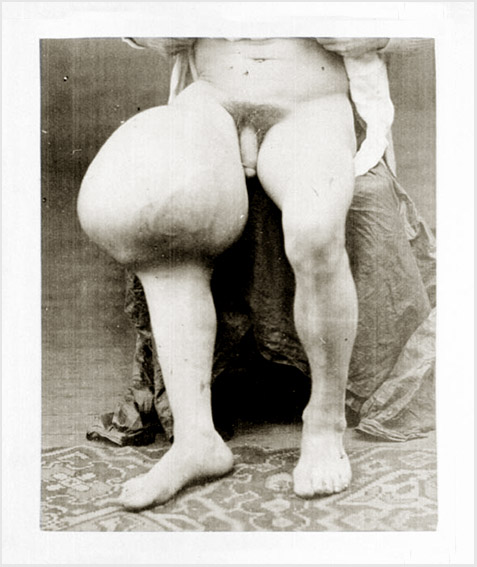
Journal : Revue photographique des hôpitaux de Paris ; vol. 4.
Paris : Adrien Delahaye, 1872.
Description : [1 l. pl.], 129-139 p. ; ill.: 1 phot. ; 24.5 cm.
Photograph : 1 mounted albumen.
Subject : Femur — Chondrosarcomas ; Amputation.
Notes :
Cette énorme masse (voy. Planche XIII), nous venons de le dire, fait corps avec le fémur, et souléve les muscles ainsi que
la peau de la cuisse.—Page 131.
Quinze jours après son entrée, on constatait que la tumeur avait augmenté de volume; en effet, la distance de son bord
supérieur à l'arcade de Fallope n'était plus que de 9 centimètres au lieu de 10 (voy. Planche XIII).—Page 132.

The 32 year-old male patient, a farmer by trade, was photographed from the level of his diaphragm and on down. He sits on a draped chair and hoists his hospital gown above the frame of the picture–only a few fingers of both hands can be seen. The picture was taken before surgery to document the enormity of the spindle cell tumor occupying the entire thigh and knee of the patient's right leg. Subject died from metastatic septicaemia, 10 days following the amputation of his leg.
In his second career as a senator, Dr. Labbé used his political influence to advance the interests of the medical community, notably the 1914 Loi Labbé legislating the compulsory antityphoid vaccinations of all French soldiers. Labbé and his colleague, Etienne Goujon (1840-1907)—who also entered politics after a career in medicine—introduced preanaesthetics (GM 5670) in a report titled, Sur l'action combinée de la morphine et du chloroforme (1872, Paris: Bulletin of the Association scientifique de France, vol. 9; pp. 413-416). Labbé had special skill in gastrotomy and he approached the stomach wall below the ninth rib. From this procedure came the one anatomical association of his name, defined as the area where the stomach touches the abdominal wall—the Labbé triangle. One of his gastrotomies became an international sensation with the tabloid headline, "The man who swallowed a fork" (L'homme á la fourchette).
